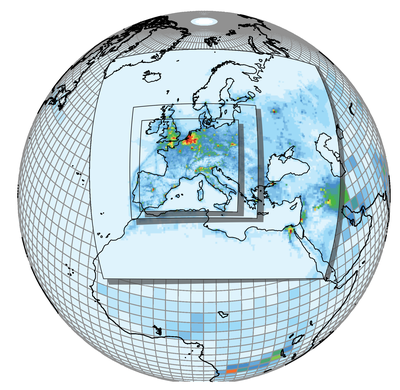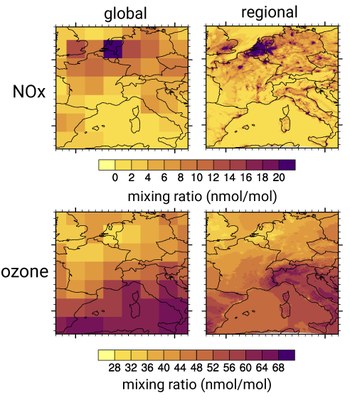Usually, climate impact and air quality are considered separately. Therefore, global chemistry-climate or earth system models are used to analyse the influence of emissions on the climate system. Unfortunately, the horizontal resolution of about 100 km of these models is too coarse to examine regional air quality. Such studies need a resolution of less than 50 km, as regional chemistry-climate models or regional chemistry transport models could provide.
Due to the interdependency of climate and air quality it is preferable to consider them together. For this reason, the focus of the AerChemMIP simulations within the framework of CMIP6 is to describe metrics in a transient manner, which is relevant for air quality and climate (Collins et al, 2017). Previous models allowed only a restricted simultaneous consideration. This drawback was one of the reasons to develop the MECO(n) model system. MECO(n) is short for „MESSy-fied ECHAM and COSMO/MESSy models nested n times“. It consists of the global chemistry-climate model EMAC, which is online coupled to the regional chemistry-climate model COSMO-CLM/MESSy. The "n" in the name of the model describes the number of so-called COSMO-CLM/MESSy-instances. MECO(3) for example has 3 COSMO-CLM/MESSy instances (see Figure 1).

Figure 1: Schematic illustration of a MECO(3) system with 3 instances over Europe with a horizontal resolution of 50 km, 12 km and 7 km, respectively. As an example, near surface mixing ratios of nitrogen dioxide is superimposed.
The necessary meteorological and chemical boundary conditions for the regional model instances are provided online from the next coarser model instance (EMAC or COSMO-CLM/MESSy). Similar as for the different components of an earth system model, all model instances run simultaneously, and thus the exchange of boundary values is done efficiently with the Message Passing Interface (MPI) communication. A temporary storage of data is therefore unnecessary.
MECO(n) is further developed and maintained by the MESSy-consortium. The original development was realized within the project MACCHIATO (Modeling of atmospheric chemistry and transport from global to local scales), funded by DFG. Further development is ongoing through the MESSy-consortium. For instance, in the framework of the HGF-ESM project the representation of aerosols in the regional model was improved.
DKRZ’ resources are most important for the development and model simulation in serveral scientific projects. The model configuration for a detailed analysis of air quality in Europe uses 40 compute nodes and needs roughly 11,000 node-hours for the simulation of one month.
The biggest challenge, however, is the disk space for storing the data. Using comprehensive tropospheric and stratospheric chemistry, as well as additional diagnostics to estimate the original source of emissions and their interaction with ozone, over 200 tracers need to be defined. These have to be stored with a high temporal resolution (1 hour) for an analysis of air quality aspects. The output for a one month simulation produces 15 Terabytes. Such resources of computing performance, storage and archive is only provided by DKRZ in Germany.
Using MECO(n) it became possible to study specific processes in detail on a regional scale. The main focus is set on chemical processes and related air quality aspects. The regional representation is most important for non-linear processes, where the results of a global model can not simply be linearly interpolated to the regional scale. An example is shown in Figure 2, where near-surface mixing ratios of nitrogen dioxide and ozone are presented for Europe in the global model (~ 300km resolution) and within the regional model (~ 7km). The regional model is not only valuable for an analysis of air quality aspects, but also for a detailed comparison with observations. This intercomparison provides the basis to identify model errors and thus helps to improve the global model, which in turn helps to improve climate projections.

Figure 2: Modelled near-surface mixing ratios of nitrogen oxide (NOx) and ozone over Europe for the global model (left) and the regional model (right).
MECO(n) is currently applied at DKRZ for the following scientific projects:
- To analyse the influence of uncertainties in the emission fields of traffic on the ozone budget in Europe. For this purpose, the emission fields of land traffic are systematically varied in different simulations and the resultant effect on the ozone and nitrogen dioxide distribution is investigated.
- Within the BMBF project AIRSPACE (Aircraft Remote Sensing of Greenhouse Gases with combined Passive and Active instruments) a forecasting system on the basis of MECO(n) was established and already successfully applied for the planning of flight campaigns.
- Besides the forecasting for campaigns, MECO(n) was further used for hindcast simulations of past campaign periods, i.e. the EMeRGe-Europe campaign in July 2017. A specific diagnostics package of the model ("tagging") helped to assign the respective emission sources to the measured concentrations. Figure 3 shows for example simulated contributions of land and sea traffic of the near-surface mixing ratios of reactive nitrogen dioxide (NOy). Similarly, contributions can also be estimated along flight trajectories (Figure 4). This diagnostic helps to interpret measurement and to evaluate model results.
- Simulation of the time period of a campaign, which was conducted within the BMBF project "Urban Climate under Change" (UC)². Local measurements improve the CO2 and CH4 emissions inventories used in the model.

Figure 3: Modelled near-surface mixing ratios of the contribution of land traffic emissions (left) and ship emissions (right) to the near-surface reactive nitrogen dioxides.

Figure 4: Simulated mixing ratios of reactive nitrogen dioxides along the flight path of the research aircraft HALO during flight measurements within the framework of the EMeRGe-Europe campaign.
It is planned for the future to select specific periods of the CMIP6 simulations, that will then be re-simulated with MECO(n) to analyse the climate aspect as well as projected developments of air quality.
The MESSy consortium:
MECO(n) is maintained and further developed by the MESSy consortium consisting of 19 international partners. Information on the partners and on MESSy: messy-interface.org
Contakt:
- Dr. Mariano Mertens, Deutsches Zentrum für Luft- und Raumfahrt e.V. (DLR), Institut für Physik der Atmosphäre, Oberpfaffenhofen (TWFyaWFuby5NZXJ0ZW5zQGRsci5kZQ==)
- Dr. Sabine Brinkop, Deutsches Zentrum für Luft- und Raumfahrt e.V. (DLR), Institut für Physik der Atmosphäre, Oberpfaffenhofen (c2FiaW5lLmJyaW5rb3BAZGxyLmRl)
Publications of the MECO(n) model system and the ozone diagnostics:
Kerkweg, A. and Jöckel, P.: The 1-way on-line coupled atmospheric chemistry model system MECO(n) – Part 1: Description of the limited-area atmospheric chemistry model COSMO/MESSy, Geosci. Model Dev., 5, 87–110, https://doi.org/10.5194/gmd-5-87-2012, 2012.
Kerkweg, A. and Jöckel, P.: The 1-way on-line coupled atmospheric chemistry model system MECO(n) – Part 2: On-line coupling with the Multi-Model-Driver (MMD), Geosci. Model Dev., 5, 111–128, https://doi.org/10.5194/gmd-5-111-2012, 2012.
Hofmann, C., Kerkweg, A., Wernli, H., and Jöckel, P.: The 1-way on-line coupled atmospheric chemistry model system MECO(n) – Part 3: Meteorological evaluation of the on-line coupled system, Geosci. Model Dev., 5, 129–147, https://doi.org/10.5194/gmd-5-129-2012, 2012.
Mertens, M., Kerkweg, A., Jöckel, P., Tost, H., and Hofmann, C.: The 1-way on-line coupled model system MECO(n) – Part 4: Chemical evaluation (based on MESSy v2.52), Geosci. Model Dev., 9, 3545–3567, https://doi.org/10.5194/gmd-9-3545-2016, 2016.
Kerkweg, A., Hofmann, C., Jöckel, P., Mertens, M., and Pante, G.: The on-line coupled atmospheric chemistry model system MECO(n) – Part 5: Expanding the Multi-Model-Driver (MMD v2.0) for 2-way data exchange including data interpolation via GRID (v1.0), Geosci. Model Dev., 11, 1059–1076, https://doi.org/10.5194/gmd-11-1059-2018, 2018.
Rieger, V. S., Mertens, M., and Grewe, V.: An advanced method of contributing emissions to short-lived chemical species (OH and HO2): the TAGGING 1.1 submodel based on the Modular Earth Submodel System (MESSy 2.53), Geosci. Model Dev., 11, 2049–2066, https://doi.org/10.5194/gmd-11-2049-2018, 2018.
Grewe, V., Tsati, E., Mertens, M., Frömming, C., and Jöckel, P.: Contribution of emissions to concentrations: the TAGGING 1.0 submodel based on the Modular Earth Submodel System (MESSy 2.52), Geosci. Model Dev., 10, 2615–2633, https://doi.org/10.5194/gmd-10-2615-2017, 2017.
References:
Collins, W. J., Lamarque, J.-F., Schulz, M., Boucher, O., Eyring, V., Hegglin, M. I., Maycock, A., Myhre, G., Prather, M., Shindell, D., and Smith, S. J.: AerChemMIP: quantifying the effects of chemistry and aerosols in CMIP6, Geosci. Model Dev., 10, 585–607, https://doi.org/10.5194/gmd-10-585-2017, 2017.
